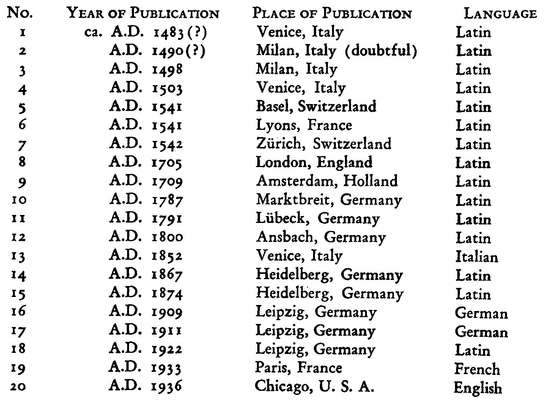A. MANUSCRIPTS
I, 9TH CENTURY
New York, Library of the Academy of Medicine, until 1930 in Cheltenham, Gloucester, Biblioth. Phillipps, 275, in the library of Sir Thomas Phillipps, a codex ca. Ninth century, 4to, parchment, 275 pp., originally bound up with Phill. 386, which is said to have come from the Benedictine Abbey of St. Ghislain, founded at the end of the 7th century in the diocese of Cambrai; partly in Continental, but mostly in Anglo-Saxon minuscle of the 9th century, not unlike the Anglo-Saxon minuscle of Fulda.
Title missing. Cf. Vollmer, Studien, pp. 5-6.
The writer who has hastily inspected the manuscript in 1931 is of the opinion that three different hands wrote this book. Part of the index is gone, too. The book commences with lib. VII of the index. Bound in an 18th century French full leather binding. It was brought to America by Dr. Margaret B. Wilson and presented to the library of the A. of M. in 1931.
II, 9TH CENTURY
Rome, Vatican Library. Vat. Vrbinas, lat. 1146, Ninth century. 58 sheets, 2 blanks in the beginning and 2 at the end. Size 23.75 x 18.75 cm., heavy parchment, 20-21 lines to the page, not numbered. Sheet 1 R, illuminated by square panel in purple and gold letters (capit. quadr.)  |API| |C| || Nothing else. Sheet 1 V 3 R the title, EPIM e || LES LI || BER I, and the titles of Book I, illuminated with columns, flowers and birds. Sheet 3 R between the foot of the columns EXPLICIVNT CAPITVLA. Sheet 3 V a panel in purple similar to sheet 1 R with inscription,
|API| |C| || Nothing else. Sheet 1 V 3 R the title, EPIM e || LES LI || BER I, and the titles of Book I, illuminated with columns, flowers and birds. Sheet 3 R between the foot of the columns EXPLICIVNT CAPITVLA. Sheet 3 V a panel in purple similar to sheet 1 R with inscription, 

 Sheet 4 R commences the text with the title, I, Conditum Paradoxum. Captions, marginal figures and initials in red. The captions are written in good uncials throughout, the first text words usually in half uncials, continuing in an even and beautiful minuscle. The Explicits and Incipits invariably in capitalis rustica. Sheet 58 V end of text with EXPLICIT LIBER X.
Sheet 4 R commences the text with the title, I, Conditum Paradoxum. Captions, marginal figures and initials in red. The captions are written in good uncials throughout, the first text words usually in half uncials, continuing in an even and beautiful minuscle. The Explicits and Incipits invariably in capitalis rustica. Sheet 58 V end of text with EXPLICIT LIBER X.
Traube, Vollmer and others believe that this manuscript was written in or in the vicinity of Tours in the 9th century.
III, 8TH CENTURY
Paris, lat. 10318. 8th century. Codex Salmasianus, pp. 196-203, Apici excerpta a Vinidario vir. inl. (See illustration.)
Excerpts from Apicius, 31 formul not found in the traditional Apicius and quite different in character. Cf. Notes on Vinidarius, preceding the Excerpta which follow the end of Book X of Apicius.
IV, 15TH CENTURY
Rome, Vatican Library, Vat. Vrbinas, lat. 1145, parchment, 15th century. 51 sheets, 20 lines to the page, title, Apicius.
V, 15TH CENTURY
Paris, lat. 8209, paper, 15th century. 131 sheets, 30 lines to the page.
VI, 15TH CENTURY
Florence, Laur. 73, 20. 15th century. 84 sheets, 26 lines to the page.
VII, 15TH CENTURY
Florence, Laur. Strozz. 67, 15th century. 50 sheets, 23 lines to the page. Title, Apicius.
VIII, 15TH CENTURY
Florence, Riccardianus, 141 (L III 29), paper, 179 sheets, irregular number of lines, pp. 123-179, Apicius. 15th century.
IX, 1462
Florence, Riccardianus, 662 (M I 26), finished April 4th, 1462, paper, 79 sheets, 26 lines to the page. Pp. 41-79 Apicius, written by Pascutius Sabinus, Bologna, 1462.
X, 1490
Oxford, Bodl. Canon. lat. 168 4to min. 78 pp. dated May 28th, 1490. (In fine) scriptum per me Petrum Antonium Salandum Reginensem die xxviii Maii MCCCCLXXXX.
XI, 15TH CENTURY
Oxford, Bodl. Add. B 110, 15th century, Italian. cf. H. Schenkl, Bibl. Britann. I. p. 79 n. 384 and F. Madan, A Summary Catalogue of Western Mss. in the Bodleian Library, Oxford, 1905, p. 660. Vollmer says that this Ms. belonged to a son of Humelbergius, as proven by P. Lehmann.
XII, 14TH CENTURY
Cesna, bibl. municip., 14th century.
XIII
A manuscript in the library of the Sforza brothers at Pesaro which burned in 1514, known only from the catalogue. Cf. A. Vernarecci, La Libreria di Gio. Sforza in Archivio storico per le Marche e lUmbria, III, 1886, 518, 790.
XIV
A manuscript used by Bonifaz Amerbach and Joh. Sichardus. Cf. P. Lehman, Joh. Sichardus, Quellen und Untersuchungen, IV, 1, p. 204.
XV-XVI
The two manuscripts mentioned by Albanus Torinus, in his edition of Apicius, Basel, 1541. In 1529 Torinus found an Apicius codex on the island of Megalona (Maguellone) which he used for his edition of Apicius. It is almost certain that this was not a very ancient manuscript. The way Torinus speaks of it and of the (first) Venetian printed edition in his epistola dedicatoria leaves even doubt as to whether his authority was handwritten or printed. A first edition, printed ca. 1483, may have well been a dilapidated copy such as Torinus describes in 1529. Torinus admits taking some liberties with the text and failed to understand some phases of it. Despite this fact, his text, from a culinary point of view seems to be more authentic than the Humelbergius and Lister versions.
The other codex according to Torinus, was found in Transsylvania by Io. Honterus of Coronea. This codex may have served as authority for the first edition printed ca. 1483 by Bernardinus, of Venice. No other mention is made of this codex anywhere, which according to Torinus, was sent to Venice from Transsylvania. The text of the Editio Princeps, by the way, is thoroughly unreliable.
XVII, 15TH CENTURY
Ms. Rome, Vatican Library, lat. 6803, 15th Century.
XVIII, 15TH CENTURY
Munich, lat. 756. Ex bibl. Petri Victorii 49. 15th century. This codex is particularly valuable and important for the identification of the Apicius text. Cf. Vollmer, Studien, pp. 10 seq .
B. PRINTED EDITIONS
SUMMARY OF PRINTED EDITIONS

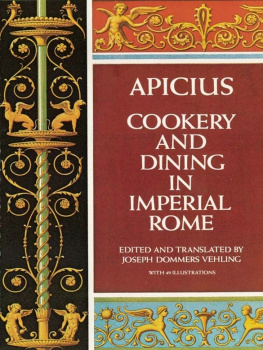




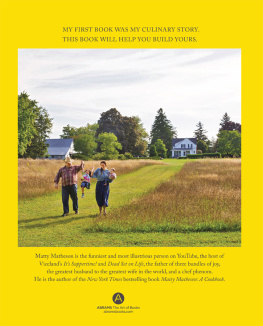





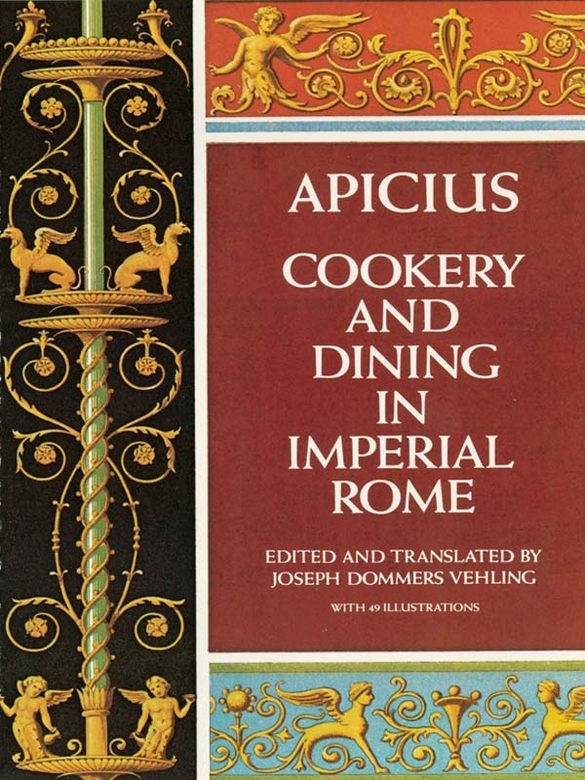
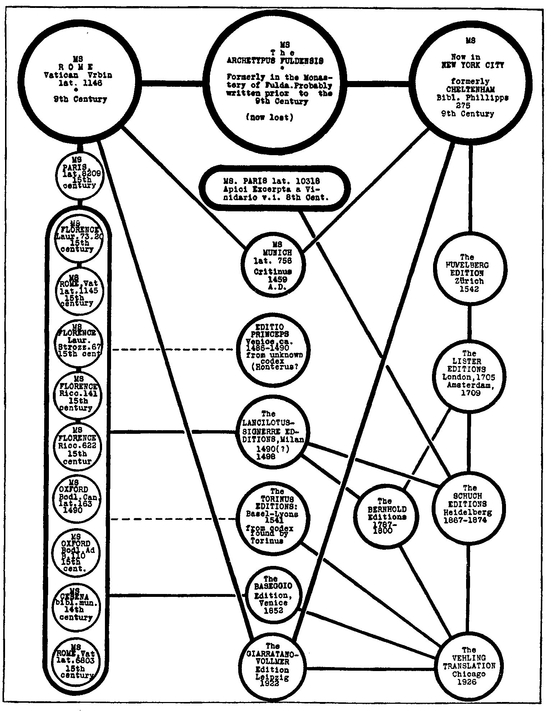
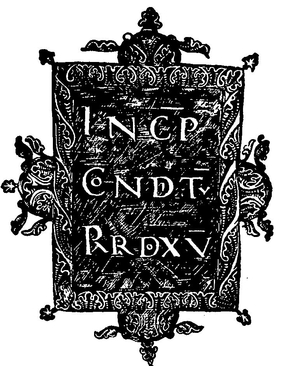
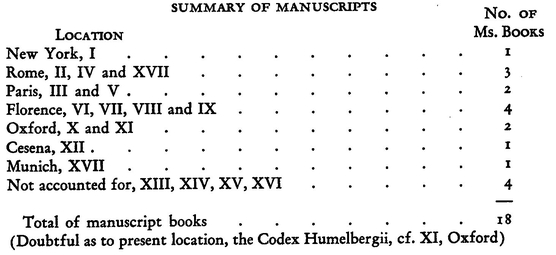
 |API| |C| || Nothing else. Sheet 1 V 3 R the title, EPIM e || LES LI || BER I, and the titles of Book I, illuminated with columns, flowers and birds. Sheet 3 R between the foot of the columns EXPLICIVNT CAPITVLA. Sheet 3 V a panel in purple similar to sheet 1 R with inscription,
|API| |C| || Nothing else. Sheet 1 V 3 R the title, EPIM e || LES LI || BER I, and the titles of Book I, illuminated with columns, flowers and birds. Sheet 3 R between the foot of the columns EXPLICIVNT CAPITVLA. Sheet 3 V a panel in purple similar to sheet 1 R with inscription, 

 Sheet 4 R commences the text with the title, I, Conditum Paradoxum. Captions, marginal figures and initials in red. The captions are written in good uncials throughout, the first text words usually in half uncials, continuing in an even and beautiful minuscle. The Explicits and Incipits invariably in capitalis rustica. Sheet 58 V end of text with EXPLICIT LIBER X.
Sheet 4 R commences the text with the title, I, Conditum Paradoxum. Captions, marginal figures and initials in red. The captions are written in good uncials throughout, the first text words usually in half uncials, continuing in an even and beautiful minuscle. The Explicits and Incipits invariably in capitalis rustica. Sheet 58 V end of text with EXPLICIT LIBER X.